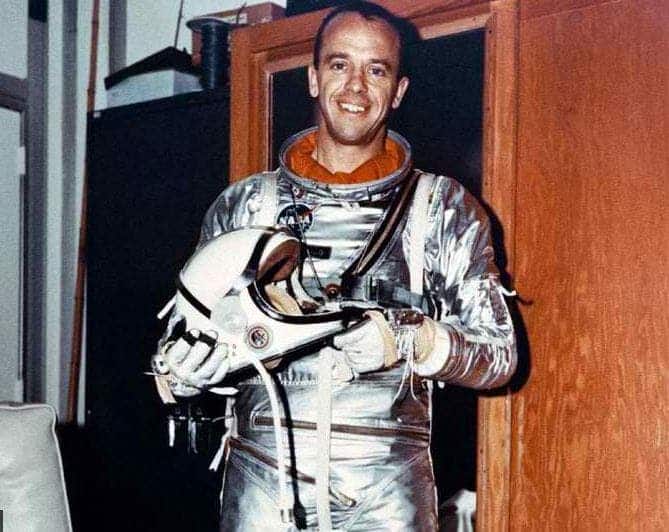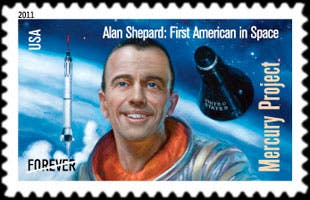Ask most Americans which three astronauts they remember most, and the answers you’ll likely get are Neil Armstrong, John Glenn and Jim Lovell. Armstrong, of course, was the first person to walk on the moon in July of 1969. Glenn is the first American to orbit the earth in February of 1962. And Jim Lovell gained fame as the Commander of Apollo 13 in April of 1970 — a mission that nearly ended in disaster.

But the astronaut that many people should remember, but often don’t, is Alan B. Shepard, Jr. Shepard was the first American in space, completing a 15-minute mission, 55 years ago today on May 5, 1961. Shepard’s flight, while it did not place him into orbit, remains a significant milestone in the history of the American spaceflight program. It catapulted the United States back into the “Space Race,” less than one month after the Soviet Union had sent cosmonaut Yuri Gagarin into orbit. Gagarin’s flight had embarrassed the United States and forced the National Aeronautics and Space Administration (NASA) to play catch-up with the Soviets.

Shepard was among the first group of astronauts, the “Mercury 7,” chosen by NASA for the manned space program. The others were Malcolm S. (“Scott”) Carpenter, Virgil I. (“Gus”) Grissom, John H. Glenn, Walter M. Schirra and Donald K. (“Deke”) Slayton. Today, only John Glenn remains alive, having become (at age 77) the oldest man to travel in space as a member of the STS-95 space shuttle Discovery mission in October of 1998.
In preparation for the first flight, NASA decided to train only three of the astronauts–Shepard, Glenn and Grissom — so the others could prepare for future orbital missions (Swenson, et. al., 1989). The flight was scheduled for May 2, 1961, but was scrubbed due to bad weather. Another weather delay caused the mission to be rescheduled to May 5th.
There was a considerable amount of trepidation as the launch date approached. To begin with, the Redstone rocket that would carry Shepard on his suborbital flight had never been tested with a human aboard. The original plan was that Shepard would only be a “passenger,” along for the ride. There wasn’t supposed to be anything for him to do but report on what he saw out the window, and what he felt during the few minutes of weightlessness he would experience. However, the astronauts lobbied NASA for some opportunity to maneuver the Mercury capsule during the flight, and NASA finally agreed to allow some basic pitch, yaw and roll maneuvers.
Other potential problems included possible malfunctions on re-entry. While the retrorockets on the spacecraft were technically not needed on this flight (the capsule had been launched on a ballistic missile trajectory, which would bring it back down no matter what), they were going to test the retros anyway. If they did not function as expected, it would result in delays for the upcoming missions.
As we know now, Shepard performed the capsule maneuvers flawlessly and the retrorockets fired as planned. There was only one more suborbital mission after Shepard’s. That was Gus Grissom’s Liberty Bell 7 flight, which concluded with the capsule sinking in the ocean after Grissom had climbed out. But that’s a story for another time.
In 1964, Shepard was diagnosed with Meniere’s Disease, an inner-ear syndrome which causes dizziness, nausea and vertigo. He was removed from flight status until 1969, when a new medical procedure cured him of the problem. In 1971, he commanded the Apollo 14 lunar mission, becoming the fifth (and oldest, at age 47) person to walk on the moon. Shepard died of leukemia in 1998, at the age of 74.
Why was Shepard’s flight so significant? First, it proved that the Mercury technology was reliable. Second, it became the first step towards reaching the moon. In fact, less than three weeks later, on May 25th, in an address to a joint session of Congress, President Kennedy committed the United States to a lunar landing before the end of 1969. The Space Race was officially on.
Reference
Swenson, L.S., Grimwood, J.M. and C.C. Alexander, 1989, This New Ocean: A History of Project Mercury. Retrieved from http://www.hq.nasa.gov/office/pao/History/SP-4201/toc.htm, 14 February, 2016.
About the Author
Dr. Steven B. Newman received his B.S. in Meteorology from the City College of N.Y. in 1973, and his M.S. and Ph.D. degrees in Atmospheric Sciences from SUNY at Albany, NY in 1975 and 1978, respectively.






